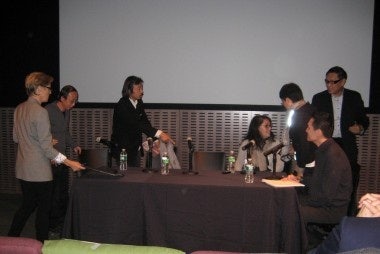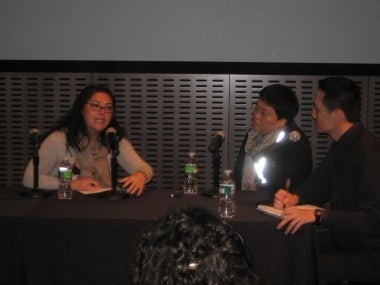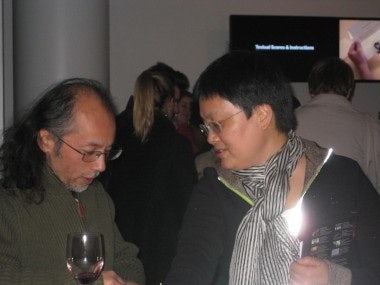Huang Rui, Huang Yongping, and Lin Tianmiao at Launch Event for Sourcebook on Chinese Contemporary Art#

Three influential artists of China’s early contemporary art scene came together at New York’s Museum of Modern Art this past Friday evening, October 15, 2010, to celebrate the publication of a new book to which they all contributed—even if they didn’t know it at the time. In a series of one-on-one conversations followed by a group Q & A, artists Huang Rui, Huang Yongping, and Lin Tianmiao (all speaking through interpreter Vincent Cheng), reflected on their experiences in the art scene that first began emerging more than 30 years ago. Their personal stories and insights brought a rapidly fading era back into colorful focus.
As reported in Jing Daily last week, the MoMA volume, Contemporary Chinese Art: Primary Documents (MoMA/Duke University Press, $40), surveys the field from 1976 to the mid-2000s, through a selection of original materials, many of which can be found at the Hong Kong-based Asia Art Archive. The book’s “primary documents” range from the “Preface to the First Stars Art Exhibition (Xingxing Meizhan),” written by Huang Rui in 1979, to the Chinese Ministry of Culture’s “Notice on its Resolution to Cease All Performances and Bloody, Brutal Displays of Obscenity in the Name of ‘Art,’” released in 2001.
Though pieced together from more than 370 documents, “There is a historical narrative embedded in the book,” editor Wu Hung told the audience. “It gives you the original voices, the feeling about the art, about the artists especially, the curators, Chinese critics—how they talked about the art, what terminology they used, how they decided which art was good or bad.” Jane DeBevoise, board chair for the Asia Art Archive, described the sheer volume of material that the Archive had amassed for its new online project, “Materials of the Future: Documenting Contemporary Chinese Art From 1980-1990," a small fraction of which found its way into the book. “So far we’ve collected hundreds of magazines, newspapers, and books published during the 1980s, digitized ten personal archives, conducted over 75 videotaped interviews, and produced a 50-minute documentary film.”
The first artist to speak was Huang Rui, co-founder of the groundbreaking group The Stars (Xingxing). In a conversation with Wu Hung, he took the audience through a video slide show recounting the original Stars exhibition, an unofficial show installed on the fences surrounding Beijing’s National Gallery in 1979. He then told a humorous story about the role that Mao Zedong played in his decision to become an artist. “The third time I saw Mao Zedong in person, it was August 18, 1966,” he recalled, “for a workers’ gathering in the capital. A lot of people at that event actually cried. As for me, I had a very, very cold feeling toward the whole situation. I realized that I was very different from the rest. And that was an epiphany. It was the realization that I could become an artist.” The audience chuckled along with him as he concluded, “So I decided to find my own life.” Asked whether, at the time of the first Stars exhibition, he and his colleagues viewed their art as avant-garde, Huang Rui responded that “the audience for the show gave us two labels. They told us we were avant-garde, and we agreed that that was quite fitting. The other label was ‘anti-system,’ ‘anti-official,’ ‘anti-state apparatus.’ And we also agreed with that.”

In the evening’s second conversation, between Jane DeBevoise and Huang Yongping, DeBevoise recalled the late 1970s and early 1980s, after the Cultural Revolution, as a time of “Reading Fever.” Suddenly, Western and traditional Chinese texts were readily available, and were avidly devoured by Chinese artists and intellectuals. Asked which books meant the most to him at that time, Huang Yongping singled out works by or about Marcel Duchamp, the philosopher Ludwig Wittgenstein, and Zen Buddhism. “At the time, I called them ‘the three legs,’ the trinity,” he recalled. “People pointed out that these were three very different, unrelated books or philosophies, and asked why I put them together. I think that ultimately they are discussing the same thing, which is the idea of how things end.” He added, “It’s not about understanding them, but about using your heart to be moved by them.”
After Huang Yongping completed his art school training he was sent back to Xiamen, a provincial city in southeastern China, where he taught middle-school students. “At the time, in the 1970s and 1980s, it was hard for us to use the term ‘artist’ to describe ourselves,” he reflected. “I myself was an art teacher, and there were a lot of workers who were producing art, so the concept of ‘artist’ was different from the way we use it now. That came later on. At the time it was hard to have an exhibit, so we had to find friends, so we could do it as a collective. A lot of the things we did at the time were very spontaneous, and we initiated them without any advance planning. For this one particular exhibition [in Xiamen in 1986], after the exhibition we decided to burn all the work. We didn’t have a lot of audience members around—we just thought that it was fitting to do this.”

For her conversation, Lin Tianmiao was joined by Sarah Suzuki, Assistant Curator of Prints and Illustrated Books at MoMA. While a video slide show of her work played in the background, Lin Tianmiao recalled what it was like to return to Beijing in 1994 after ten years of living in Brooklyn. “There weren’t any places for art exhibition,” she explained. “It was really, really difficult to find a place to show our work.” So Lin Tianmiao, with her husband, video artist Wang Gongxin, turned their traditional-style living quarters into a sub rosa exhibition space, which they called the Open Studio. “I just needed to make phone calls,” she said, “and people would come and see the show.” Concerned about drawing attention from the police—who had already detained artists of the East Village collective after one of their shows—Lin Tianmiao and her colleagues showed works for “two hours only. We would close very quickly and all the audience members would disperse right away.” She realized much later that “a lot of artists emulated our model, of showing works for two hours and then closing down.” Triggering laughter from the audience—and perhaps rueful recognition from more feminist-minded listeners—she recalled artist friends who would turn up at Open Studio shows expecting to be fed. “I used to cook them a home-made meal,” she said, but quickly decided “I couldn’t stand this anymore” and switched to buying prepared food instead. That strategy also rapidly lost its appeal. “I remember one time going to the store and purchasing eighty servings of noodles just to feed my friends who had come to see the show,” she said, shaking her head.
All six conversationalists returned to the stage for a lively audience Q & A. After the evening’s many reminiscences, the opening question abruptly thrust the conversation back into 2010: “In the wake of Liu Xiaobo winning the Nobel Peace Prize, how much solidarity do you feel with contemporary activists for human rights, and do you feel that artists have an obligation about that?”
Invited by Wu Hung to respond first, Huang Rui replied: “Basically, I would say ‘no.’” Lin Tianmiao commented: “Art is art and politics is politics. It’s hard enough just to do the artworks and just let the artists be.” After reflecting a moment she added, “We had a meeting this past spring, and a lot of artists didn’t even recognize Liu Xiaobo’s name.” Huang Yongping, a longtime resident of France, took a different view: “I definitely think that there’s some association between art and politics, but I do think that as an artist you can only take on a general attitude with politics—not ‘This is the only thing I do.’ This is part of life, and you are a citizen of your country. That’s the way I see politics.”
Wrapping up the evening, Wu Hung talked about similar launch events that had already taken place in Beijing, Shanghai, and Hong Kong. “We invited many Chinese artists and critics, who came and saw this book,” he said. “The general reaction was very positive, very excited. Just to see the book, to see their own words translated and treated very seriously.” He added that the polished editorial format—in particular, the detailed index—also impressed Chinese audiences. “Because you know, in China, everything moves very fast, they publish many, many things,” he said, “but the quality is often not very professional. This MoMA book, in one single volume, sets a standard. They can see that. So I feel that already there has been a kind of cultural exchange.”
Article by Susan Delson